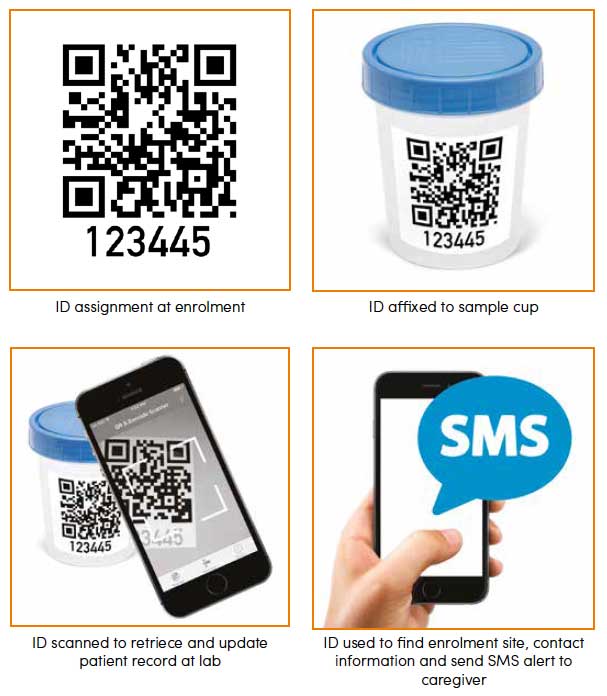-
1. Introduction
-
2. Translating data into action: essential components of a TB recording and reporting system
-
3. Designing an optimal information system
-
4. Recommended process of development
-
5. Resource requirements
-
6. Measuring the impact of the information system
-
References
3.2 Key system components
Patient identifiers
UPIs are a cornerstone of a good information system. A UPI is used to link patients to their test results, follow-up visits, and outcomes and to ensure that reporting is done correctly. If implemented broadly, UPIs may also be used to link patient data across systems, for example between the LIMS and the treatment initiation tracking system. Unfortunately, UPIs are not always straightforward to implement. The decentralized nature of TB programmes coupled with the fact that many systems are used offline makes it difficult to generate UPIs in real-time at the point of care in most settings. While national ID numbers, where available, can be used as UPIs, it must be kept in mind that vulnerable and marginalized populations in many settings do not have national IDs (and are often those most in need of care). Therefore, provisions must be made for these situations.
Other options for UPIs include biometrics (most commonly fingerprints), but these require specialized equipment and infrastructure for registering and searching. In addition, fingerprints are often difficult to accurately match for young children and those involved in manual labour (e.g. miners). Another possibility is pre-printed, centrally generated UPIs in the form of barcodes or text on sticker paper distributed to health facilities. These can then be pasted onto a physical ID given to the patient (please see Figure 6). Given that physical IDs can be lost, however, an optimal system would make it possible to search for patients to a reasonable degree of accuracy using other criteria such as date of birth, name, phone number, etc. It is important to note that the link between the UPI and the individual patient information should only be accessible at the level of care.
Case-based data for the entire care continuum, including “active alerting”
Ideally, an information system for TB patient management should enable the recording and reporting of individual patient data at every step in the care cascade from screening to diagnosis, notification, treatment initiation, follow-up tests and visits and through to outcome, including referral. Patients re-enrolled in treatment (e.g. due to relapse or determination that the patient has DR-TB) should appear in the system with a link to their prior treatment record, thus presenting an integrated view of a single individual’s history and facilitating more effective management of patient data.
Active alerts
Active alerts are an important way to keep programme staff informed of important intervention points in the case cascade for a patient or key programmatic event. For example, active alerts regarding missed follow-ups, positive diagnoses, drug supply below minimum thresholds and other similar events enable programme staff to adopt a more active intervention approach, unlike a passive approach whereby staff need to open a report or patient record to view this information. Alerts can be implemented in different ways, depending on the context in which the system is operating. Examples include pop-ups when logging in to a web-based system, SMS alerts sent to a phone, visual alerts on a mobile app, or even email alerts. It is useful for the system to have a mechanism for users to indicate that they have responded to an alert.
Linkages with national health information and inventory infrastructure
The TB information system should link with the country’s central health information system (if there is one) and/or to other appropriate health systems, e.g. HIV, inoculation tracking systems. This means that the variables being collected by the TB information system should align with the country’s national indicators and variables. While national case-based systems are not common, many countries do have national aggregate data systems like DHIS2; it is important for the TB information system to link with the national system so that the government has access to correct and complete data for national reporting and decision-making. It is important for TB programmes to keep track of inventories, particularly drug inventories. Understanding where medicines are located, when they need to be replenished, and how to transfer them between locations when needed can be part of the functionality of the information system. For example, India’s NIKSHAY system allows district TB offices to plan procurement of medicines. Information systems that are linked to laboratories can also be used, for example, to update lab inventory such as GeneXpert cartridges, smear slides, etc. Similarly, information systems that track drug disbursement can be used to track drug inventory.
Geographical Information
A key part of an optimal information system is the ability to view data geographically on a map. Being able to see facilities on a map and understand where patients are seeking care can help programmes to identify gaps in the health system as well as disease clusters. The Indus Hospital MDR-TB system stores GPS-encoded locations of patients in its database, which can then be displayed on a map (see Figure 7). For community-based programmes, recording the location of each data entry event (e.g. a screening event) and then viewing these locations in a geographical information system can offer an important window into understanding how community health workers operate. For example, it may be possible to track the route taken by community health workers in order to shed light on their day-to-day work. The ability to display notification trends graphically using charts or maps is especially useful in identifying unusual changes or spikes over time or in particular areas. Some concerns over privacy and the use of GPS and GIS mapping have recently emerged. Consequently, implementers need to be aware of these concerns in order to protect patient privacy and prevent stigma against particular communities.


